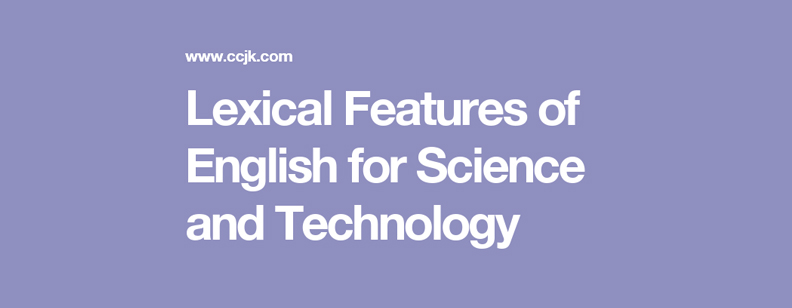Every field of study has its own specific vocabulary, but most people would agree that specific vocabulary of science and technology is particularly large, obscure and splintered. Words are the basic elements of language. Apparently, it is of vital importance to grasp the main lexical features of EST. Thus, this chapter is devoted to a brief exploration of EST lexicon.
Vocabulary is a most important feature of scientific writings. According to Peter Newmark, “Technical translation is primarily distinguished from other forms of translation by terminology, although terminology usually only makes up about 5-10% of a text’s contents”.
A: Usage of Large Number of Greek and Latin Roots
Many English words derive from Greek and Latin roots. Taking the following two groups of words as examples: equilibrium, equivalent, equinox, equidistant, equation; isotherm, isobar, isochronous, isomorphism, and isotope. It is easy to find that the words in the first group share the similar root “equi”, which is a Latin root, and the second group with the Greek root “iso”.
The meaning of these two roots is equal. Such analogous examples can be frequently seen English words, such as the root “alacer” means quick, the “annus” refers to year, etc. If the readers know the meaning of the root, they can easily have a related guess to the strange words, and the next time when they encounter with them, they could have a better understanding of them.
We also take the words optimum and maximum as examples. The meaning of the word optimum in scientific and technical English is equivalent to the meaning of the word best in general English and it is identical to maximum and best. What’s the difference between these two words?
Many people may be confused by their meanings and the subtle difference between them if they do not understand the roots of Greek and Latin roots. As a matter of fact, these two words all are from Latin words optimums(最好)and maximums(最大).
Extensive and continued use of Greek and Latin words as the main source for technical names has established in the nomenclature of the major sciences. A modern scientific field can, therefore, by constructing its terminology on the base of the Greek and Latin, fruitfully ally itself with other scientific field.
B: Word Formation in EST Lexicon
Many scientific and technical words are formed according to the basic rules of word formation. On the whole, the EST lexicon, as the language carrier for modern science and technology, can be classified into the following five:
Are you looking for Technology Industry Translation? We are here for your assistance.
◆ Conversion: Conversions refer to change part of speech of the given word into another kind of part of speech, which frequently appears in EST sentences as following examples:
Water (noun. 水) → water(verb.浇水); dry(adj.干的)→dry(verb. 烘干)
Yield(noun.产率)→yield(verb.生成); charge(noun.电荷)→charge(verb, 充电)
◆ Acronym: Acronyms are formed with the initial letters, which are extensively used in scientific and technical English. They are very convenient to employ this brief form, For example:
CET—College English Test (大学英语等级考试)
IAEA—International Atomic Energy Agency(国际原子能机构)
IELTS—International English Language Testing System (雅思)
◆ Derivation: Derivation is an important means of creating new English words with prefix and suffix, which are treated as inseparable elements of the words being coined. Here are some examples:
mini- 小型;微型 sub- 在…下;亚;半
minicomputer 微型计算机 subzero 零下的
◆ Combination: “Combination is the way of combining at least two words to form a new one”.2 EST words created by compounding always appear with three forms:
(1) With a hyphen
by-product 副产品 rust-resistance 防锈
(2) Without a hyphen
makeup 化妆品 online在线
(3) Two or more words forming a word combination
Read Also: Information Communication Technology
carbon steel 碳钢 time-consuming operation 耗时作
◆ Blending: “Blending is regarded as a variant of compounding, which omitted the latter part of the first word and clipping off the first part of the second word.” (刘宓庆 377)The following are some examples:
Smog= smoke+ fog 烟雾 Aldehyde= alcohol+ dehydrogenation 醇+脱氢=醛
Medicare= medical+ care医疗保障 Modem= modulator+ demodulator 调制解调器
Blended words are found more often in EST texts than others. In this way, words of EST could be made shorter, and the sentences composed of these words could be made more concise.



